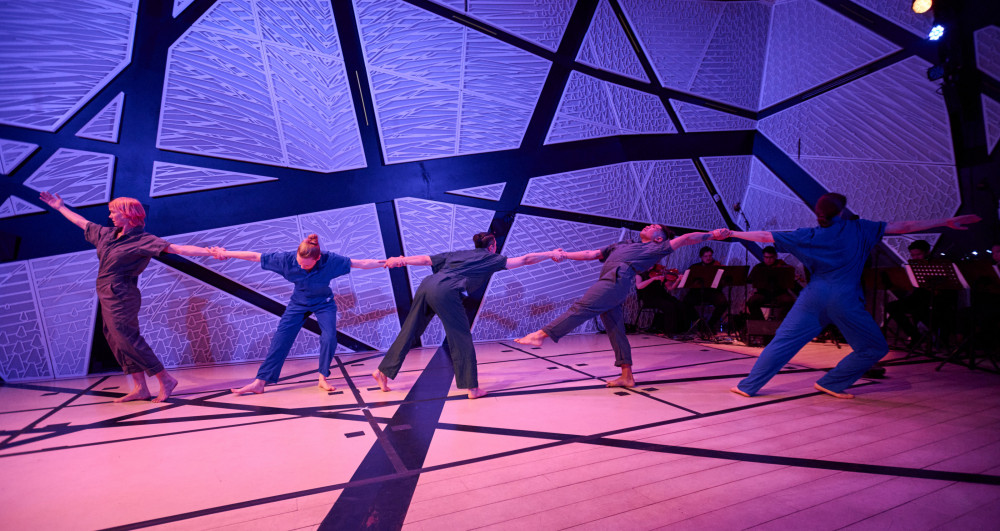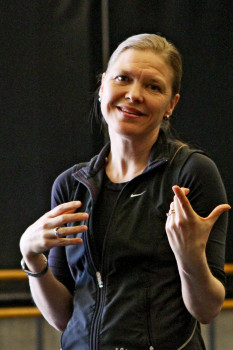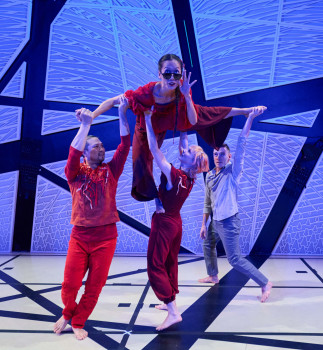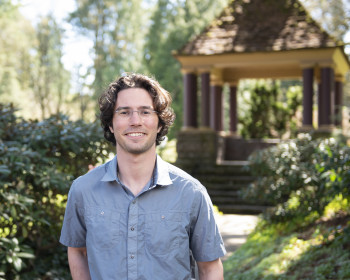L&C’s New Dance Moves
Lewis & Clark adds a dance concentration, which will be led by Tiffany Mills, the college’s new director of dance.

Credit: Robert Altman
Choreographer Tiffany Mills has been hired as the new director of dance at Lewis & Clark College. She officially stepped into the role this spring, ready to lead the program into its next chapter, which includes a new theatre department concentration in dance.

Credit: Julie LembergerMills, choreographer and artistic director of the New York–based Tiffany Mills Company, is already very familiar with the strengths of the department and its students. Over the last two decades, Mills has been commissioned to create hybrid work for multiple colleges, universities, and dance companies and has engaged with Lewis & Clark students as a guest artist, twice.
“I love being able to integrate my professional and academic worlds,” says Mills. “I’m now working with seniors whom I first met when I was a guest artist at Lewis & Clark. So, in a way, it feels like a natural progression.”
Mills admires the strong creative element that is a hallmark of Lewis & Clark students.
“There’s an openness and a creative willingness,” she says. “I love the conversations that ensue. Lewis & Clark students are very thoughtful and rigorous in their ideas.”
Known for her hybrid work that brings together dance and other genres of performance, Mills has enjoyed significant national and international recognition from audiences, press, presenters, and funders. She will continue as artistic director of the Tiffany Mills Company relying, in part, on an innovation enabled by the COVID-19 pandemic: the ability to attend rehearsals virtually. There are also plans in the works for her company to do a residency next April, teaching classes and performing with students.
“This is a really exciting time for theatre and dance at Lewis & Clark,” says Rebecca Lingafelter, associate professor of theatre and department chair. “We are thrilled to be able to offer a dance concentration for the theatre major and to have an artist of Mills’s caliber to build on the exceptional work of her predecessor and our dedicated faculty.”
A trend toward hybrid performance
Mills is passionate about cross-pollinating forms and melding dance with theatre, film, music, literature, visual art, and environmental studies.
“Having dance in a theatre department sings to me because of the work that I do, which is really at the intersection of dance and theatre,” says Mills. “I regularly work with a theatre director and a dramaturg. I’m really about the marriage of those forms.”

Credit: Robert AltmanThe new dance concentration will not only provide undergraduate students with the option to focus their studies on dance, it will also foster a more fully integrated approach to movement and theatre, better preparing students for the professional world.
“The trend toward hybrid performance is a reflection of the performing arts field at large,” says Lingafelter. “Many of us on the faculty are working at the intersection of dance, theatre, and performance. With the recent hire of Mills, we have elevated the visibility of that work to a national level.”
Students are eager to center their studies on dance, says Lingafelter. In fact, two current seniors have chosen to focus their thesis work on dance. Both students have said they would have declared a dance concentration if it had been made available.
“Dance is for everybody.”
The expansion of the dance program offers benefits to the campus community beyond the theatre department, says Mills.
“In my classes right now, I have a cross section of students from the whole campus,” she says. “Half are theatre majors, but the others are focused on a wide variety of majors, including those in the sciences. I also have three football players taking my technique class.”
Not all students who take dance classes at Lewis & Clark will pursue it professionally, says Mills, but they are keen to have movement remain a part of their lives.
“They say, ‘Oh, this is such a great balance. I can go and study now because I’ve moved.’”
Lingafelter echoes that sentiment, saying that the new concentration expands access to the positive mental health and wellness outcomes that dance offers students.
“All students who participate in our dance classes—whether they are majors, minors, or members of the general population—leave our classes with experiential methods and tools for self-care that benefit them not only during their college years, but for the rest of their lives,” says Lingafelter.
Mills is also excited to build on the community connections that faculty members like Eric Nordstrom, visiting instructor in dance, have beyond campus.
“I think it would be really fabulous to have guest artists from Portland engage with our students,” says Mills, who also hopes to someday offer summer classes on campus that are open to community members. Dance is for everybody.”
More Newsroom Stories
Public Relations is located in McAfee on the Undergraduate Campus.
MSC: 19
email public@lclark.edu
voice 503-768-7970
Public Relations
Lewis & Clark
615 S. Palatine Hill Road MSC 19
Portland OR 97219

